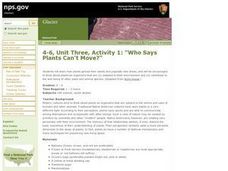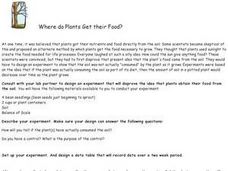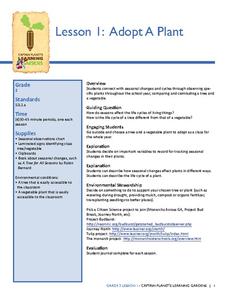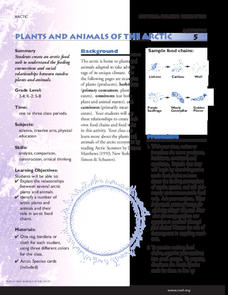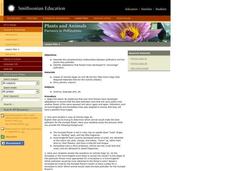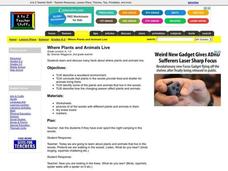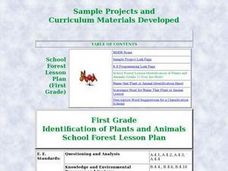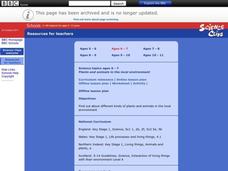Curated OER
Coral Polyp Party
Learners complete a project where they label the parts of a coral polyp and discuss the differences between plants and animals. Students use marshmallows, sprinkles, toothpicks, and more to label their coral polyp.
Curated OER
Who Says Plants Can't Move?
Learners discover how plants spread their seeds using other plants and animals. In this plant lesson, students role play different plants and how their seeds travel. Learners then have a class discussion to ensure their understanding.
Curated OER
Force of Habitat
Plants and animals of the desert are the subject of this instructional activity. While the activities involve an exploration involving Nevada, this resource could be altered for use with any area. This detailed instructional activity...
Curated OER
Prairie Scavenger Hunt
Middle schoolers take a close look at the prairie environment. They identify common plants and animals of the prairie. In addition, pupils work in teams in order to put together a presentation on a certain aspect of the prairie...
Curated OER
Where Do Plants Get Their Food?
Plants need food to survive, just like any other living organism. Young biologists analyze an experiment performed in 1610 by Jan van Helmont to determine if plant nutrition is obtained through the soil. First, lab groups work together...
Curated OER
Life Cycles of Plants and Animals
What a cute way to introduce life cycles through a PowerPoint! The pictures and basic stages of the lives of butterflies, frogs, and plants are shown with cartoon pictures. there is also a prompt for your pupils to consider other life...
Curated OER
Flora and Fauna of the Hill Neighborhood
Students compare and contrast the characteristics of plants and animals. In this ecology lesson plan, students observe the outdoors and describe the relationship among different living things. They relate plant diversity with animal...
Curated OER
Benefits of Indoor Plants
Young scholars diagram a plant. In this Science lesson plan, students explore the concept of photosynthesis focusing on the oxygen production. Young scholars calculate the amount of plants needed to filter the air in their classroom.
Curated OER
Introduction to Watsonville Wetlands
Identify the different plants and animals found in wetlands, your class will explain the importance of wetland ecosystem and locate the different wetlands in their area.
Captain Planet Foundation
Adopt-A-Plant
Note the way that plants change during the season by adopting a plant on your school campus. After your class chooses their plant, they research the plant's needs, how it differs from other plants, find ways to support their plant's...
Curated OER
Plants and Animals Word Search
In this science worksheet, students examine labeled pictures of birds, plants and mammals. Students locate the names in a word search puzzle.
Curated OER
Temperature
Young biologists discover that plants and animals have protective parts that help them to survive during periods of harsh conditions. After a meaningful class discussion, pupils complete three worksheets by working in pairs to reinforce...
National Wildlife Federation
Plants and Animals of the Arctic
The Arctic food web may be more limited than other environments, but it has all the same components. With an interactive activity, pupils assume the roles of the components of an Arctic food chain. They move around and link themselves to...
Curated OER
Plants and Animals, Partners in Pollination
Students participate in multiple hands-on activities to explore reproduction and pollination. In groups, using a cotton swab and powder, students simulate being pollinators and plants. They name the parts of the flowers and the function...
Curated OER
Plants and Animals: Partners in Pollination
Students describe the complementary relationships between pollinators and the plants they pollinate, identify adaptations that flowers have developed to "encourage" pollination, and create and draw their own "designer" flowers.
Curated OER
Plant Parts and their Function
Discover why plants are important to our world. View plant parts and categorize them as stems or buds. Students do a cut and paste of pictures of plants into correct categories. Students also plant a carrot top,and record...
Curated OER
Where Plants and Animals Live
Students explore and discuss facts about a woodland environment, the plants and animals that live there, and changing seasons in the woods. They conclude that plants in the woods provide food and shelter for animals living there.
Curated OER
Plants and Animals
Students discuss the different types of plants and animals in a local environment. In this science lesson, students name some plants and animals understanding that they require different habitats to live. Students use computers to...
Curated OER
Plants and Animals of Great Bay Animals and Plants of the Estuary
Students participate in a webquest about the plants and animals that inhabit an estuary. They role play as environmentalists researching this habitat and present the results of their research in a creative way.
Curated OER
Identification of Plants and Animals
First graders identify a variety of plants and animals that can be found in the school forest, then differentiate between plants and animals. They find examples of characteristics used to differentiate between plants or animals.
Curated OER
Rainforest Plants and Animals -- Where Are They?
Students identify the plant and animals in the rainforest. Using the internet, they research how these plants and animals adapt to survive in this type of environment. In groups, they critique artwork and discuss how they were depicted.
Curated OER
Plants and Animals in the Local Environment
Learners recognize the different types of plants and animals living in a local environment. They determine how they require different habitats to live, and relate simple life processes to plants and animals found in local environments.
Curated OER
Plants And Animals in the Local Environment
Students observe the various living things they can find outside their playground making sure to look both on the ground and in the air. They develop a large poster Venn digram, as a class, of plants and animals that live in the air, on...
Curated OER
Arizona Plant Booklet: An Introduction to Arizona Plants & Cacti
Students explore variety of plants & cacti in their Arizona community by collecting samples and taking photographs. Can be adapted to other areas.
Other popular searches
- Arctic Plants and Animals
- Aquatic Plants and Animals
- Coastal Plants and Animals
- Artic Plants and Animals
- Plants and Animals Needs
- Animals and Plants
- Plants and Animals Interact
- Desert Plants and Animals
- Plants and Animals Die
- Attic Plants and Animals
- Comparing Plants and Animals
- Animals Plants and Water



